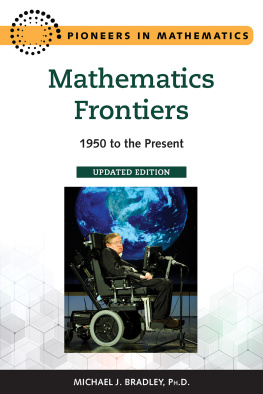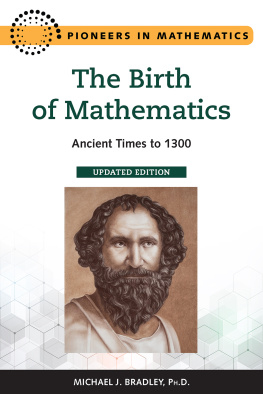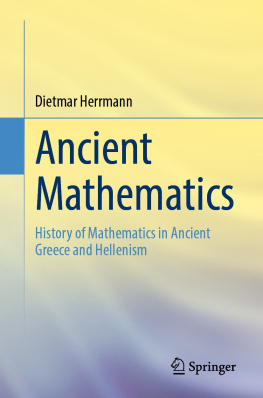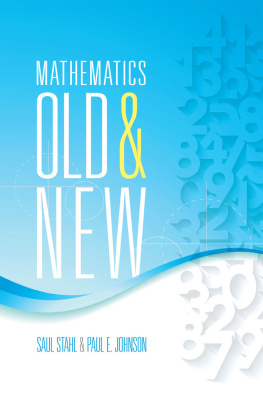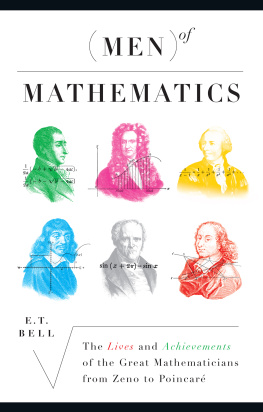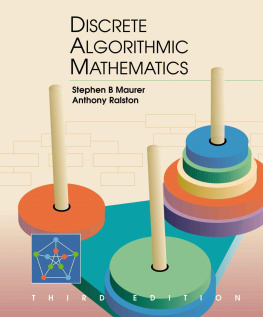Mathematics Frontiers, Updated Edition
Copyright 2019 by Michael J. Bradley
All rights reserved. No part of this publication may be reproduced or utilized in any form or by any means, electronic or mechanical, including photocopying, recording, or by any information storage or retrieval systems, without permission in writing from the publisher. For more information, contact:
Chelsea House
An imprint of Infobase
132 West 31st Street
New York NY 10001
ISBN 978-1-4381-8230-8
You can find Chelsea House on the World Wide Web
at http://www.infobase.com
Preface
Mathematics is a human endeavor. Behind its numbers, equations, formulas, and theorems are the stories of the people who expanded the frontiers of humanity's mathematical knowledge. Some were child prodigies while others developed their aptitudes for mathematics later in life. They were rich and poor, male and female, well educated and self-taught. They worked as professors, clerks, farmers, engineers, astronomers, nurses, and philosophers. The diversity of their backgrounds testifies that mathematical talent is independent of nationality, ethnicity, religion, class, gender, or disability.
Pioneers in Mathematics is a five-volume set that profiles the lives of 50 individuals, each of whom played a role in the development and the advancement of mathematics. The overall profiles do not represent the 50 most notable mathematicians; rather, they are a collection of individuals whose life stories and significant contributions to mathematics will interest and inform middle school and high school students. Collectively, they represent the diverse talents of the millions of people, both anonymous and well known, who developed new techniques, discovered innovative ideas, and extended known mathematical theories while facing challenges and overcoming obstacles.
Each book in the set presents the lives and accomplishments of 10 mathematicians who lived during an historical period. The Birth of Mathematics profiles individuals from ancient Greece, India, Arabia, and medieval Italy who lived from 700 B.C.E. to 1300 C.E.The Age of Genius features mathematicians from Iran, France, England, Germany, Switzerland, and America who lived between the 14th and 18th centuries. The Foundations of Mathematics presents 19th-century mathematicians from various European countries. Modern Mathematics and Mathematics Frontiers profile a variety of international mathematicians who worked in the early 20th and the late 20th century, respectively.
The 50 chapters of Pioneers in Mathematics tell pieces of the story of humankinds attempt to understand the world in terms of numbers, patterns, and equations. Some of the individuals profiled contributed innovative ideas that gave birth to new branches of mathematics. Others solved problems that had puzzled mathematicians for centuries. Some wrote books that influenced the teaching of mathematics for hundreds of years. Still others were among the first of their race, gender, or nationality to achieve recognition for their mathematical accomplishments. Each one was an innovator who broke new ground and enabled their successors to progress even further.
From the introduction of the base-10 number system to the development of logarithms, calculus, and computers, most significant ideas in mathematics developed gradually, with countless individuals making important contributions. Many mathematical ideas developed independently in different civilizations separated by geography and time. Within the same civilization, the name of the scholar who developed a particular innovation often became lost as his idea was incorporated into the writings of a later mathematician. For these reasons, it is not always possible to identify accurately any one individual as the first person to have discovered a particular theorem or to have introduced a certain idea. But then mathematics was not created by one person or for one person; it is a human endeavor.
Introduction
Mathematics Frontiers, the fifth volume of the book set Pioneers in Mathematics, profiles the lives of 10 mathematicians of the second half of the 20th century. Each has left his or her own mark, but collectively they constitute a cross section of the international mathematics community during an era when that community became more diverse and when the United States emerged as a leading center for mathematical research. This period of years also witnessed the resolutions of many long-standing open problems, significant developments in both pure and applied mathematics, and the introduction of new mathematical ideas that made possible major technological advances.
The mathematicians profiled in this volume exemplify a growing diversity within the mathematical community. The advancement of mathematical knowledge today draws on the talents of individuals from all nationalities, races, ethnicities, and genders. This particular group of women and men from the United States, Great Britain, Hong Kong, Taiwan, Belgium, and Ireland are representative of the broader international community of scholars.
During the latter half of the 20th century, the United States rose to prominence within the international mathematical community. The Institute for Advanced Study in Princeton, New Jersey, emerged as a leading research center, attracting many of the world's top mathematicians for extended periods of collaboration. The establishment of strong research groups at many U.S. universities and at industrial sites such as Bell Laboratories in New Jersey drew prominent scholars from around the world and fostered the development of talented young people. Although only three of the 10 mathematicians profiled in this book were born in the United States, eight of them spent or have spent the majority of their careers at American institutions.
Several of these mathematicians solved problems that had resisted solution for many years. Julia Robinson's work of more than 20 years with Diophantine equations produced research results that were essential in solving Hilbert's 10th problem, a question that mathematicians had been investigating since the beginning of the 20th century. Shing-Tung Yau solved the Calabi conjecture about geometrical properties of surfaces and many other open problems in differential geometry. In one of the most celebrated mathematical achievements of the century, Andrew Wiles proved Fermat's last theorem, a problem that had remained unsolved for more than 300 years.
Mathematicians in the 20th century made significant discoveries in both pure and applied mathematics. John H. Conway helped complete the classification of all finite groups, invented the Game of Life, and performed extensive mathematical analysis of other games of strategy. J. Ernest Wilkins, Jr., developed techniques for radiation shielding to guard against the effects of the gamma rays produced by nuclear reactions. Stephen Hawking established the mathematical basis for black holes and other advanced theories in mathematical physics. John Nash won the Nobel Prize in economics for his introduction of Nash equilibrium for cooperative and noncooperative games.
Advances in mathematics made possible many of the technological developments of the electronic age. Fan Chung developed an encoding and decoding algorithm for cellular telephone calls and analyzed aspects of the mathematical structure of the network of computers that forms the Internet. Ingrid Daubechies's development of Daubechies wavelets led to new image processing techniques for fingerprint analysis, computer animation, and medical imaging. Sarah Flannery developed a new cryptographical method for securely and efficiently transmitting coded messages.

